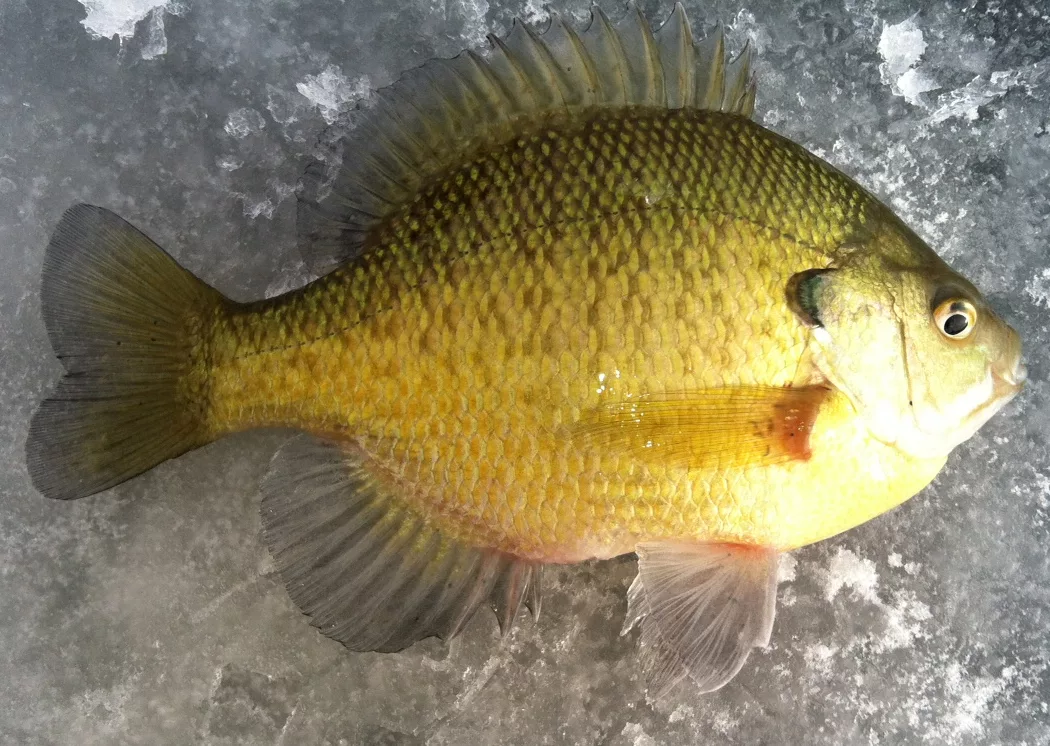
To the Gills. To catch more panfish at mid-ice, consider downsizing both lures and line diameter to catch bigger bluegills along with crappies and perch. Simonson Photo
By Nick Simonson
The middle of winter brings with it funky fish and some changes in your presentation and efforts are required in the doldrums of February to not only find them but also to convert lookers into takers under the ice. With a few simple hacks at mid-ice, the action can stay white hot, even as we come out of what is traditionally the coldest part of the year.
Small Minded
Maybe not so much in this unseasonably warm winter, but in most seasons, the ice this time of year is getting thicker and fish slow down as oxygen levels reach their lowest point and food becomes a bit more scarce after the bounty of summer has waned. With those factors, fish become a bit more lethargic and pickier about the offerings you send down to them. Going smaller in terms of lures, and utilizing thinner line is a good way to adjust to the changing attitude of fish at mid-winter. Use tungsten ice jigs to get a solid drop down to panfish such as perch, crappies and bluegills and even shedding one pound, and going from four-pound test to three-pound test, can make those presentations more appealing to those discerning fish this time of year when they look your bait over and make the decision to strike.
Working On It
The other challenge of the season’s thickest ice comes with punching holes, and typically the more holes you cut, the more options you’ll have to catch fish. This may require a bit of extra work or sharing the auger duties with a buddy to find that spot-on-a-spot, but cutting a large grid over an area that holds fish will help you narrow down the best location to set up for a day or a weekend trip on the ice. Stay mobile and keep those shoulders and arms pumping to get as many holes in the ice as needed for success, and don’t forget to pack an extra battery for those electric augers and have a full gas tank for the day on those traditional models to help fuel the exploratory efforts.
Mix It Up
Having both a passive presentation of live bait, such as a small minnow on a hook beneath a slip float and a more active option in the hole adjacent to it, such as any jig or spoon that catches the attention of nearby fish or those cruising around the area, will help increase your odds of success at mid-ice. The active lure serves as the attention-getter, and most fish will at least come in to see what all the commotion is about. Even if they don’t bite on it, they’ll be able to pick up on the more natural presentation sitting a couple feet away, and often when they pass on the jumping spoon or twitching jig, they’ll cruise on over to easily inhale the minnow flitting about nearby.
In Motion
Finally, movement is key at mid-winter. Have a selection of go-to spots for each day’s outing and explore them efficiently to find active fish or ideal structure that brings them in and holds them. Target those areas where fish such as walleyes and crappies move in low light conditions during dawn and dusk and be there at the appropriate times. Being in the right place at the right time for the fish you are after is half of the battle at mid-winter. Identify the places you think fish will be, explore them with a grid of holes, and if nothing shows or fish are negative, move on to the next waypoint and return if you think things will change with the fading of the day or onset of night.
While this season is quite a bit different across the region when compared to last year, the same hallmarks of midwinter apply. Adjust your tackle, increase your auger usage, have a couple of options for fish arriving in your area and keep moving to find the best success at mid-ice…in our outdoors.
